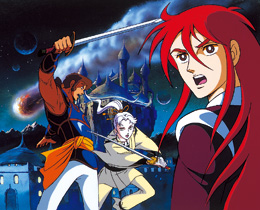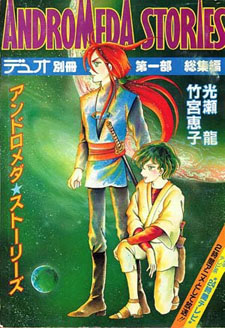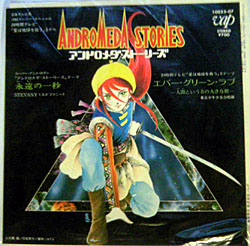Welcome to the fifth installment of my Tezuka Pro TV Specials series. This is the one not produced by Tezuka Pro. I can already hear you asking, “Wait a minute; what?”
Andromeda Stories. August 22, 1982. 85 minutes. Directed by Masamitsu Sasaki. Written by Masaki Tsuji, animation by Shigetaka Kiyoyama; from the manga written by Ryu Mitsuse and drawn by Keiko Takemiya. Music by Yuji Ono. Production by Tōei Dōga.
 For some reason that I have never seen explained, Nippon Television’s animated feature in its 1982 “Love Saves the Earth” annual telethon was not by Tezuka Productions. Presumably this was not because NTV was dissatisfied with Tezuka Productions’ work, because the TV network went back to Tezuka Productions in 1983. Instead, NTV’s 1982 “Love Saves the Earth” animated feature was by Tōei Dōga, and it was an adaptation of the manga Andromeda Stories, written by Ryu Mitsuse but, more importantly, drawn by Keiko Takemiya.
For some reason that I have never seen explained, Nippon Television’s animated feature in its 1982 “Love Saves the Earth” annual telethon was not by Tezuka Productions. Presumably this was not because NTV was dissatisfied with Tezuka Productions’ work, because the TV network went back to Tezuka Productions in 1983. Instead, NTV’s 1982 “Love Saves the Earth” animated feature was by Tōei Dōga, and it was an adaptation of the manga Andromeda Stories, written by Ryu Mitsuse but, more importantly, drawn by Keiko Takemiya.
Takemiya was the “hot” manga artist/author of the moment, having written & drawn To Terra … (mistranslated as Toward the Terra at the time), as a multiple award-winning serialized manga in 1978 to 1980, and animated as a 115-minute theatrical feature by Tōei Dōga in April 1980, released just as the manga was ending. Andromeda Stories was minor in comparison. Takemiya just drew it; she did not write it. The story was not considered as good. But it had the Takemiya look, and that was what counted then.
 I never saw the animated feature at the time. I read (looked at Takemiya’s art) the manga about 35 years ago, and all that I can remember is that the story made no sense without being able to read the text. From the few one- and two-paragraph plot synopses online, here is a summary of the TV movie, which is simplified considerably from the manga:
I never saw the animated feature at the time. I read (looked at Takemiya’s art) the manga about 35 years ago, and all that I can remember is that the story made no sense without being able to read the text. From the few one- and two-paragraph plot synopses online, here is a summary of the TV movie, which is simplified considerably from the manga:
On the planet Astria in the Andromeda galaxy, popular Prince Ithaca of Cosmoralia (or the Cosmoralian Empire) marries beautiful Princess Lilia of Ayodoya. Part of the ceremony is the crowning of Ithaca as King Astralta III. This is supposed to lead to a Golden Age for all Astria. They have two children, the twins Jimsa and Affle. Meanwhile, unknown to anyone, Astria is infiltrated by mysterious machines that take over people. All that the people know is that King Astralta and his ministers suddenly become distant and emotionless, and that this spreads. Astria is terraformed from a green, beautiful planet into a mechanical world without any natural life. When alien AI killer machines openly attack the remaining humans on Astria, Queen Lilia flees with the children into the desert, but they are separated. Lilia and Jimsu grow up with a guerrilla underground led by High Priest Kufu from the planet Murat, the previous world conquered by the AI machines. They are guided by the robots Arc and Beta. Affle, alone, is disguised as a boy. She grows up under the tutelage of Il, a cyborg female ronin, another refugee from Murat.
 When the Queen and two children, now teenagers, are reunited, it turns out that a cabal of Murat refugees have been controlling Astrian society for generations, and breeding Astria’s royal families for perfection and super-powers. The two royal teenagers must be persuaded to use their separate energy beam powers together against the machines. They each can shoot energy beams; when they join together, the beams are magnified. When this is only temporarily slows down the machines, Kufu and Il finally destroy them completely by blowing up the whole planet. Jimsa and Affle, who seem to have fallen in love, are sent far into space to safety in a space capsule, to ultimately become the Adam and Eve of a primitive lifeless planet (Earth?) through their cells after their deaths evolving over eons into higher lifeforms and finally humans again. There are suggestions that the two will eventually meet again through reincarnation. (This seems vaguely incestuous, although it presumably will not matter after billions of generations.)
When the Queen and two children, now teenagers, are reunited, it turns out that a cabal of Murat refugees have been controlling Astrian society for generations, and breeding Astria’s royal families for perfection and super-powers. The two royal teenagers must be persuaded to use their separate energy beam powers together against the machines. They each can shoot energy beams; when they join together, the beams are magnified. When this is only temporarily slows down the machines, Kufu and Il finally destroy them completely by blowing up the whole planet. Jimsa and Affle, who seem to have fallen in love, are sent far into space to safety in a space capsule, to ultimately become the Adam and Eve of a primitive lifeless planet (Earth?) through their cells after their deaths evolving over eons into higher lifeforms and finally humans again. There are suggestions that the two will eventually meet again through reincarnation. (This seems vaguely incestuous, although it presumably will not matter after billions of generations.)
This is certainly a different interpretation of Love Saving the Earth. Andromeda Stories, the manga, has been published in America by Vertical, Inc. in 2007-’08, in three volumes of 200+ pages each, credited to Takemiya alone, that is available on Amazon.com today. The anime is much harder to find. There was a Spanish VHS release titled Historia de Andrómeda in 1982. The current writeup on the Spanish Animecion website lists the production as “duraba 105 minutos, pero que a España nos llegó censurado y recortado hasta los 85, ya que nos llegó a través de Estados Unidos, responsables de dicho recorte, …” Since the original Japanese telecast was only 95 minutes, and that presumably included ten minutes of commercials, I wonder if it was really ever 105 minutes anywhere. There was apparently an American, presumably English-language, VHS release of 85 minutes in 1982. It was released most recently as an 84’40” Toei Video DVD in Japan on June 25, 2007, but that release seems to be out of print today. Here is a video of it from the Internet.
Andromeda Stories complete video


 Fred Patten (1940-2018) was an internationally respected comics and animation historian. He has written about anime or comic books for publications ranging from Animation Magazine and Alter Ego to Starlog. He was a contributor to The Animated Movie Guide (2005), and is author of Watching Anime, Reading Manga (2004, Stone Bridge Press), a collection of his best essays, and Funny Animals and More (2014, Theme Park Press), based upon his early columns here on Cartoon Research. He passed away on November 12th, 2018.
Fred Patten (1940-2018) was an internationally respected comics and animation historian. He has written about anime or comic books for publications ranging from Animation Magazine and Alter Ego to Starlog. He was a contributor to The Animated Movie Guide (2005), and is author of Watching Anime, Reading Manga (2004, Stone Bridge Press), a collection of his best essays, and Funny Animals and More (2014, Theme Park Press), based upon his early columns here on Cartoon Research. He passed away on November 12th, 2018.





































I never saw the animated feature at the time. I read (looked at Takemiya’s art) the manga about 35 years ago,
Thanks for being honest! Obviously that’s all we could do then anyway unless we had learned to read Japanese already and could do it.
There are suggestions that the two will eventually meet again through reincarnation. (This seems vaguely incestuous, although it presumably will not matter after billions of generations.)
We’ll just have to tell ourselves that, Fred. 😛
The anime is much harder to find. There was a Spanish VHS release titled Historia de Andrómeda in 1982.
There’s always some country/market that was luckier than us. I recall Right Stuf International did license the “To Terra…” movie 20 years back for their subtitled VHS release (as “Toward the Terra”). They could’ve licensed this if it was available at the time.
We analyzed it in our Anime Culture class. The topic was Teenagers in anime: behavioral approach to cultural phenomena.
Stanley Baum
https://www.writemyessayfast.ca